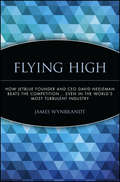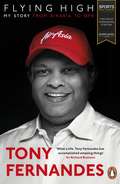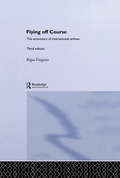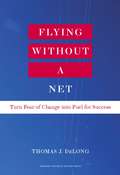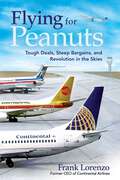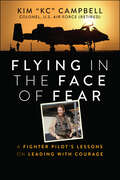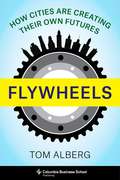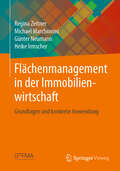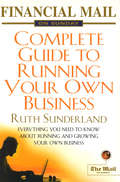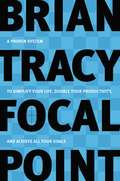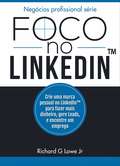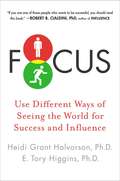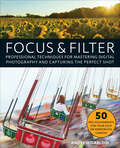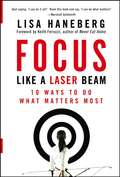- Table View
- List View
Flying Boats: Air Travel in the Golden Age
by Charles WoodleyFlying Boats: Air Travel in the Golden Age sets out to do justice to a time of glamorous, unhurried air travel, unrecognisable to most of today’s air travellers, but sorely missed by some. During the 1930s, long-distance air travel was the preserve of the flying boat, which transported well-heeled passengers in ocean-liner style and comfort across the oceans. But then the Second World War came, and things changed. Suddenly, landplanes were more efficient, and in abundance: long concrete runways had been constructed during the war that could be used by a new generation of large transport aircraft; and endless developments in aircraft meant they could fly faster and for further distances. Commercial flying boat services resumed, but their days would be numbered.
Flying High
by James WynbrandtFlying High traces the incredible career of the founder and chairman of JetBlue, David Neeleman, from his teenage ventures and beginnings in the travel industry. , to his short stint at Southwest Airlines and the ultimate launch of JetBlue. In a series of interviews with Neeleman's friends, associates, and high-ranking officials in both business and aviation, this books tells the store of Neeleman and explores the rules of success he both lives and builds his companies by.
Flying High, Landing Low: Strengths and Challenges for U.S. Air Transportation
by Rosabeth Moss Kanter Ai-Ling Jamila Malone Aditi JainThe U.S. air transportation system flies high on some indicators, mostly involving capacity to take to the air, but lands low on others, mostly involving ground facilities and processes. This note provides an overview of the history and current state of air transportation in the U.S., covering industry costs; types of airlines, including passenger and cargo (e.g., Delta, Southwest, Alaska, and Frontier); airport issues; and the role of technology. It reviews some opportunities for innovation that will solve the pain points and bottlenecks facing the system and outlines high-priority policy areas. It becomes clear that individual airlines have often been managed back to health and focus on innovation, but the overall system itself and its governmental connections need attention, including the desire for NextGen air traffic control and revisiting Open Skies agreements.
Flying High: My Story: From AirAsia to QPR
by Tony Fernandes'What a life. Tony Fernandes has accomplished amazing things - and who's to say what he can go on to achieve?' Sir Richard BransonThe inspiring story of business hero and Apprentice Asia star Tony FernandesAs a boy, Tony Fernandes wanted to be a pilot, a footballer or a racing driver. By 2011 he'd gone one better: founding his own airline and his own formula one team, and becoming Chairman of Queens Park Rangers, helping them reach the Premier League again after a 15-year absence from the top flight. Flying High is the memoir of an exceptional business leader; the man who created Asia's first budget airline, democratizing air travel in Asia and building AirAsia into a multi-billion-dollar company in the process. Published as Tony returns as the face of the second series of Apprentice Asia, this inspiring personal story will be a major global publishing event.Tony Fernandes studied at Epsom College, UK, and the London School of Accoutancy. He worked for Virgin Communications and Warner Music before acquiring AirAsia and relaunching it as Asia's first low-cost carrier in 2001/2. He is currently Group CEO of AirAsia, Chairman of QPR football club and owner of the Caterham F1 team. Tony has been awarded a CBE, titled twice by the King of Malaysia and awarded the Legion d'Honneur by the French government. He has also received awards from major business media outlets including theInternational Herald Tribune, Business Times, Business Week, Fast Company and Forbes.
Flying J (A)
by Lauren Barley Rohit DeshpandeThe largest retailer of diesel fuel in the U.S., Flying J, is rethinking its growth strategy as the economy goes into a recession. Its major customer base, owner-operated truck drivers, are facing increasing costs of doing business. Yet Flying J is considering whether to increase its price of diesel fuel.
Flying Off Course: The Economics of International Airlines
by Rigas DoganisIn the years since the first edition of Flying Off Course appeared, the international airline industry has changed dramatically. Deregulation has become widespread and has brought with it new operating practices and management concepts. This revised and updated edition reflects these changes. Key aspects of the industry are expertly analyzed including issues such as: * the factors affecting airline costs* the problems of pricing* airline marketing and product planning* the impact of United States deregulation* European air transport after 1992* the crisis in airfreight; and the economics of charters. Flying Off Course provides a fascinating and topical insight into the working of international transport as seen from an economist's viewpoint and will be a key text for those involved in the field.
Flying Without a Net
by Thomas J. DelongConfronted by omnipresent threats of job loss and change, even the brightest among us are anxious. In response, we're hunkering down, blocking ourselves from new challenges. This response hurts us and our organizations, but we fear making ourselves even more vulnerable by committing mistakes while learning something new.In Flying Without a Net, Thomas DeLong explains how to draw strength from vulnerability. First, understand the forces that escalate anxiety in high achievers and the unproductive behaviors you turn to for relief. Then adopt practices that give you the courage to "do the right things poorly" before "doing the right things well."Drawing on his extensive research and consulting work, DeLong lays out:- Roots of high achievers' anxiety: fear of being wrong and lack of a sense of purpose, and a craving for human connection- Destructive behaviors we adopt to relieve our anxiety: busyness, comparing ourselves to others, and blaming others for our frustrations- Behaviors we must adopt to gain strength from vulnerability: putting the past behind us and seeking honest feedbackPacked with practical advice and inspiring stories, Flying Without a Net is an invaluable resource for all leaders seeking to thrive in this Age of Anxiety.
Flying for Peanuts: Tough Deals, Steep Bargains, and Revolution in the Skies
by Frank LorenzoLessons in business and life from the executive who helped shape the modern airline industry Frank Lorenzo is the epitome of the American dream. A first-generation American and entrepreneur, Lorenzo started an airline advisory business in his mid-twenties based on little more than bravado and ultimately rose to control the largest fleet of airplanes in the free world. Flying for Peanuts recounts how Lorenzo grew his empire from nothing and helped shape the airline industry as we know it.Flying for Peanuts explains how the son of Spanish immigrants put himself through Columbia College by driving a Coca-Cola truck and then grew the fledgling advisory into ownership of Texas International Airlines. At TIA, he fought through the industry&’s transformation, in part by introducing the new, low-cost model for fares that are a major part of the industry today. From there, through a series of shrewd moves and a hostile takeover, Lorenzo became CEO of Continental Airlines, a large loss-making west coast airline at the time. This airline business memoir gives a play-by-play of the high-stakes negotiations that got Lorenzo there, including faceoffs with Carl Icahn and a chapter devoted to selling the Eastern Airlines Shuttle to Donald Trump, soon to become the doomed Trump Shuttle. It details Lorenzo&’s competition with upstarts like Southwest Airlines and the clashes with unions that led Fortune&’s to name him one of &“America&’s toughest bosses,&” along with accolades from his employees. Along the way, Lorenzo highlights the strategies and tactics that propelled his growth.Flying for Peanuts is a compelling read for anyone interested in the American airline industry and anyone wanting to apply a trailblazing executive&’s lessons for their own career success.
Flying in the Face of Fear: A Fighter Pilot's Lessons on Leading with Courage
by Kim CampbellProven principles of leadership from a veteran fighter pilot and military leader In Flying in the Face of Fear: Lessons on Leading with Courage, former fighter pilot and retired Air Force Colonel Kim Campbell delivers an inspiring and practical discussion of leadership and decision-making. In the book, you’ll follow the author’s journey through the principles that got her through her 24-year career in the high-stakes and high-risk world of aerial combat. You’ll discover lessons and stories that will serve as a resource for you as you lead your students, employees, and others through the challenges of life and work, learning to create a positive impact and make a big difference in the lives of the people who follow you. You’ll also find: Specific strategies and techniques for leading in situations of extreme stress and risk Methods for female leaders to overcome the challenges of working in male-dominated environments Ways to act in critical moments by recognizing that being brave and afraid at the same time is both normal and necessaryAn essential leadership blueprint for business and military professionals seeking to improve their ability to inspire others to greater achievements, Flying in the Face of Fear will also earn a place in the libraries of young and mid-career professionals looking for mentorship and sound, proven advice.
Flying into the Future: HondaJet
by Gary P. Pisano Jesse ShulmanThis cases examine Honda’s diversification into the light jet market. In 1985, Honda initiated a secret program to develop a small jet. Over the years, the program had many ups and downs (it was almost canceled several times). Then, a breakthrough in the configuration of the engines lead Honda to believe it could successfully introduce a very light jet to the market (the “Civic” of the private jet market). In 2015, the company’s HondaJet received FAA certification. The HondaJet is now the number one selling jet in the very light jet segment of the market, and the CEO of Honda Aircraft Corporation, Michimasa Fujino (who started with the program in 1985) must now decide on ways to grow the business.
Flywheels: How Cities Are Creating Their Own Futures
by Tom AlbergOnce a blue-collar outpost, Seattle, home to Microsoft, Amazon, and hundreds of startups, transformed into one of the world’s major innovation hubs in less than twenty years. As other cities try to solve the riddle of creating vibrant economies, many have looked to Seattle as a model for tech-driven urban renaissance. However, that success comes with skyrocketing housing costs, increasing homelessness, public safety concerns, persistent racial inequality, and a widening gap between the haves and have-nots. Against that backdrop, big tech has become a popular target.Tom Alberg, a venture capitalist who was one of the first investors in Amazon, draws on his experience in Seattle’s tech boom to offer a vision for how cities and businesses can build a brighter future together. He explores ways that cities can soar to prosperity by creating the conditions that encourage innovation. Like flywheels, livable cities generate momentum by drawing creative citizens who launch businesses. Success attracts more talent, energizing local economies and accelerating further innovation. Alberg emphasizes the importance of city governments and tech companies partnering to address civic challenges. He reflects on why the benefits of the tech boom have not been distributed equally and what business and government leaders must do differently to ensure inclusive growth. The book also examines success stories from smaller cities and their lessons for other up-and-coming tech hubs. Demonstrating the need for innovative thinking that encourages livability alongside economic growth, Flywheels is timely reading for everyone from mayors to business leaders to engaged citizens.
Flächenmanagement in der Immobilienwirtschaft: Grundlagen und konkrete Anwendung
by Regina Zeitner Michael Marchionini Günter Neumann Heike IrmscherDie Kenntnis der Bedeutung und korrekten Ausweisung von Flächen sind für das Facility Management einer Immobilie von großer Bedeutung.Dieses Buch führt in die Thematik des Flächenmanagements ein und gibt Aufschluss über richtige Ausweisung von Flächen in der Praxis. Für die wirtschaftliche Betrachtung einer Immobilie sind diese Angaben eine entscheidende Grundlage. Sie dienen zur Aufstellung des Raumprogramms, zur Kalkulation von Baukosten sowie zur Ermittlung der Einnahmen und Bewirtschaftungskosten. Flächenstandards, -flexibilität und -effizienz sind nicht nur in der gewerblichen Immobilienwirtschaft von Bedeutung. Das Benchmarking zur Bewertung von Flächen und Flächenkosten, die interne Leistungsverrechnung und die IT-Unterstützung für ein funktionierendes Flächenmanagement sind weitere wichtige Aspekte, die in diesem Buch behandelt werden.
Flüchtlingsstandort Deutschland – eine Analyse
by Anabel Ternès Lisa Herzog Karolina Zimmermann Margaryta Udovychenko Peter Ustinov StiftungDieses Buch zeigt die Chancen und Herausforderungen auf, die sich in Gesellschaft und Wirtschaft durch Flüchtlinge ergeben. Die Autoren analysieren die aktuelle Flüchtlingssituation und deren Hintergründe grundlegend. Sie zeigen, wie die Generation Y zur Flüchtlingsfrage steht und mit dieser umgeht. In diesem Kontext erläutern sie, wie ein interkulturelles Miteinander gelingen kann.
Flüchtlingsströme und gemischte Migration: Bewältigung einer drohenden humanitären und wirtschaftlichen Krise
by Bimal GhoshDieses Buch bietet eine aufschlussreiche Analyse der sich abzeichnenden Flüchtlings- und gemischten Migrationskrise im Kontext von vier großen, aktuellen Migrationsströmen: zwei in West- und Osteuropa und jeweils einer in Amerika und Asien. Auf die Analyse folgt in jedem Fall eine kluge Identifizierung der Schlüsselfragen und die Präsentation einer Reihe von Vorschlägen für politische Antworten. Die Diskussion wird dann in einen globalen Rahmen gestellt und mit der kürzlich gestarteten Initiative der Vereinten Nationen zur Verabschiedung von Global Compacts für Flüchtlinge und Migranten verknüpft. Der Autor bringt in dieses Buch, das erste seiner Art, seine umfangreiche Erfahrung aus der Beratung und aktiven Zusammenarbeit mit vielen der wichtigsten internationalen Organisationen ein, die sich mit Flüchtlings- und Migrationsfragen befassen. Dieses Buch wird für Forscher, Studenten, NRO, Berufsverbände, nationale Ministerien, internationale Organisationen und Rechtsgruppen in den Bereichen Wirtschaft, öffentliche Finanzen, politische Ökonomie, Menschenrechte und Flüchtlingsrecht sowie internationale Beziehungen und Demografie von Interesse sein.
Fmos Guide To Running Your Own Business
by Ruth SunderlandThis one-stop handbook covers everything you need to know: starting out; making your business special; people; enterprise for beginners; marketing; cash management; finance; innovation; export know-how; risks and rewards; avoiding the pitfalls and moving on.Packed with case studies from an enormous variety of businesses, this book draws extensively on the stories of successful entrepreneurs from Financial Mail's unique Enterprise Awards programme, It also covers the issues that everyone with their own business should and must consider, from how to get paid promptly (and what to do if not) to advertising, personnel, the business implications of the euro and how to get investment for future growth.
Focal Point: A Proven System to Simplify Your Life, Double Your Productivity, and Achieve All Your Goals
by Brian TracyThe Wall Street Journal business bestseller with over 50,000 copies sold! The true secret of high achievers is that they know how to find their "focal point" - the one thing they should do, at any given moment, to get the best possible results in each area of their lives. In Focal Point, Tracy brings together the very best ideas on personal management into a simple, easy-to-use plan. Focal Point helps readers analyze their lives in seven key areas and shows them how to develop focused goals and plans in each. This best-selling guide provides timeless truths that have been discovered by the most effective people throughout the ages, answering questions like: * How can I get control of my time and my life? * How can I achieve maximum career success and still balance my personal life? * How can I accelerate the achievement of all my goals? Focal Point shows readers how to develop absolute clarity about what they want, and how they can achieve supreme satisfaction, both personally and professionally.
Foco no Linkedin
by Richard G Lowe Jr Jonathan R. Santos & Aleff E. OliveiraAumente vastamente seu potencial de venda, promovendo-se efetivamente no LinkedIn. Aprenda a escrever seu perfil no LinkedIn e garanta mais e melhores conexões, um fluxo de ofertas de emprego e leads para seu negócio. Se você deixar o seu perfil no LinkedIn do jeito que está agora, as chances serão mínimas. Não importa quão excelente você é, você ainda vai estar preso a mesma tarefa maçante, pouco gratificante. Ou ainda quer ficar lutando diariamente para obter leads para seu negócio depois de 5 anos? Está feliz de trabalhar dia após dia em um emprego insatisfatório e ingrato, ou está tentando sem sucesso encontrar pessoas que estão interessadas em seus produtos e serviços? Ou você prefere ter oportunidades de emprego e negócio que vêm até VOCÊ, oferecendo-lhe emprego ou até mesmo pagando para VOCÊ, apenas aprendendo a escrever seu próprio perfil no LinkedIn capaz de atrair pessoas certas diretamente para sua caixa de entrada? Eu estive onde você está hoje. Eu trabalhei em cargos que me eram insatisfatórios e para empregadores que não se importavam e não recompensavam um trabalho bom e competente. Permaneci em empregos assim por anos, enviando milhares de currículos, na esperança que alguém iria reconhecer meu valor. Para ganhar mais dinheiro, eu tentei criar meus próprios produtos e serviços e procurei desesperadamente por formas de comercializá-los. Devo ter tentado centenas de diferentes métodos de marketing e de promoção, com um limitado e conturbado sucesso. O que me ajudou a crescer foi muito estudo, treinamento especializado e experiência prática. E mais importante, eu acreditei em mim mesmo e no valor que eu poderia fornecer aos empregadores e clientes para meus produtos e serviços. No início, ficava feliz em encontrar um novo cliente de vez em quando para fazer algum dinheiro extra. Mas depois, aprendi a me promover eficazmente e os cliente
Focus
by Heidi Grant Halvorson E. Tory Higgins"A must-read for anyone who wants to understand why they behave as they do." --Art Markman, Ph.D., author of Smart Thinking Do you play to win? Or do you play not to lose? As Tory Higgins and Heidi Grant Halvorson have discovered in their work at Columbia University's Motivation Science Center, everything we do is motivated either by a desire to be better off or to simply hang on to what we've got. And understanding the simple but crucial difference between the two can empower you to motivate yourself and influence everyone around you. Examining how promotion/prevention focus applies across a wide range of situations--from selling products to managing employees to raising children to getting a second date--Halvorson and Higgins show us how to identify, change, and use focus to get the results we want.
Focus
by Heidi Grant Halvorson E. Tory HigginsWe all want to experience pleasure and avoid pain. But there are really two kinds of pleasure and pain that motivate everything we do. If you are promotion-focused, you want to advance and avoid missed opportunities. If you are prevention-focused, you want to minimize losses and keep things working. And as Tory Higgins has found in his groundbreaking research, if you understand how people focus, you have the power to motivate yourself and everyone around you.Showing how promotion/prevention focus applies across a wide range of situations from selling products to managing employees to raising children to getting a second date, Halvorson and Higgins show us how to identify focus, how to change focus, and how to use focus exactly the right way to get results. Short, punchy, and prescriptive, Focus will help you see not just what's going on around you-- but what's underneath.Visit the author's website at www.heidigranthalvorson.com for a special pre-order giveaway.
Focus & Filter: Professional Techniques for Mastering Digital Photography and Capturing the Perfect Shot
by Andrew DarlowFree yourself from Auto Mode with indispensable tricks and techniques for professional-quality photos with your DSLR or mirrorless camera. Revealing insider secrets and easy-to-learn techniques for stunning photos, this book teaches you how to take beautiful images anywhere with DSLR or mirrorless cameras. Focus & Filter, a must-have guide by award-winning photographer Andrew Darlow, features fifty techniques, fifty Pro Assignments, and more than 250 color photographs that show you how to capture: *Candid and formal portraits *Safari-quality animal pictures *Spectacular nighttime cityscapes *Breathtaking fireworks photos *Dramatic high-speed motion *Mouthwatering food photos *Glare-free shots through glass Whether you&’re enjoying a hobby or building a career in photography, Focus & Filter includes all the technical advice you need to hone your skills, from choosing your equipment and setting up your studio to mastering camera settings, working in the field, and building rapport with your models.
Focus Financial Partners and the U.S. RIA Industry in 2014
by Luis M. Viceira Emily A. ChienIn the Spring of 2014, Rudy Adolf, CEO and founder of Focus Financial, and the two other co-founders of the firm are considering alternative growth strategies to solidify Focus Financial's position as a leading aggregator of independent wealth management firms in the U.S. Focus has grown from $3.5B in client assets at its inception in 2006 to over $70B in 2014 and it has acquired more than 30 RIA (Registered Investment Advisor) firms, capitalizing on a secular shift in investors' preferences from a traditional product and commission-driven brokerage model to a fiduciary, fee-based client advice model. <p><p> Since the 1970's, independent SEC registered investment advisors (RIAs) have been a growing segment of U.S. wealth managers, steadily winning market share from the dominant, traditional wirehouse broker-dealers. But, with more than $1.4 trillion in assets under management in 2013, the RIA industry is also at a crossroads, with aging advisors with limited succession plans and limited access to capital to fund intergenerational transfers, rising compliance and regulatory complexity, competition from new advice delivery models, and fragmentation. The case examines the RIA business model, the opportunities for growth through consolidation in this industry, and the competitive landscape in the wealth management aggregator sector through the lenses Focus Financial business model, its acquisition and M&A model for RIAs, and its wirehouse breakaway programs. The case examines Focus Financial strategy in the face of rising competition, potential growth paths, and IPO scenarios. <p> The case presents opportunities for students to explore similarities and differences between the broker-dealer and the RIA retail wealth management business models, strategies for growth and consolidation in the retail wealth management business, and issues related to incentives, organization and valuation of retail wealth management businesses.
Focus Groups: Supporting Effective Product Development
by Deana McDonagh Joe LangfordThe focus group is widely used to as a tool for increasing the understanding of users and their requirements, and identifying potential solutions for these requirements. Its main value lies in the conveyance of less tangible information that cannot be obtained using more traditional methods. Eliciting user needs beyond the functional is crucial for
Focus Like a Laser Beam
by Keith Ferrazzi Haneberg Lisa L.In Focus Like a Laser Beam, acclaimed management consultant and business blogger Lisa Haneberg offers business leaders a new way to direct their focus that, like a laser beam, is direct, fast, and on track. The book offers leaders ways to improve energy and engagement in the workplace and redirect how people communicate at work. Focus Like a Laser Beam is filled with useful suggestions for dealing with distractions and diversions and outlines the ten practices that will help leaders focus on what's most important. Know and feel the power of laser focus Get connected with your employees Have fun and be fun Relax to energize Turn meetings into focus sessions Invite a challenge Huddle Stop multitasking and put your focus where it belongs Do one great thing Let go of outdated goals, projects, and tasks

